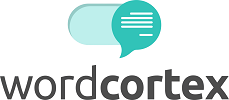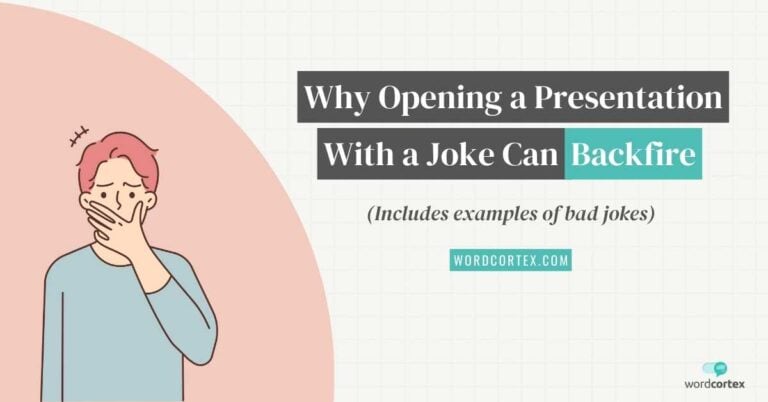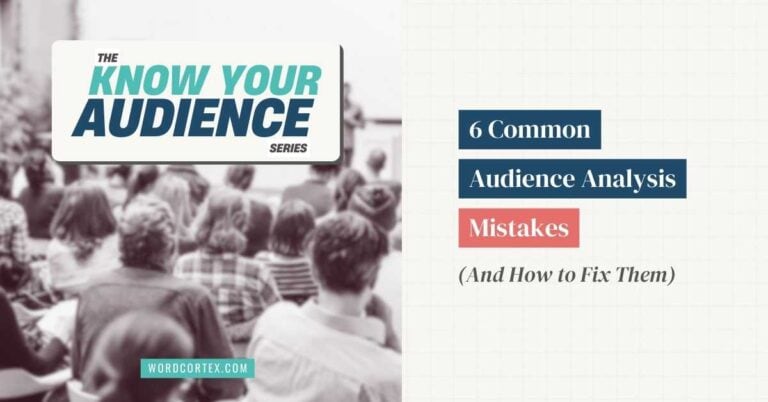Audience Analysis in Public Speaking: 3 Easy Steps & Examples
Performing an audience analysis in public speaking doesn’t have to be a complicated process.
Yet, most articles on this topic seem to over-complicate it, offering obscure, abstract terminologies without a practical step-by-step guide.
I’m guessing you’re probably tired of being told to “just consider audience demographics and psychographics”. We obviously know that! What we need is a clear roadmap for doing an audience analysis.
So, I made one.

I’ve broken down the process of audience analysis into logical steps that are super simple yet effective.
That’s what I cover in this article: 3 easy steps to knowing and understanding your audience, along with real-life examples of audience analysis for different types of presentations.
Audience Analysis in Public Speaking: 3 Easy Steps
Here are the 3 easy, logical steps to analyze your audience for a speech or presentation.
Below, as we dive into each step, I present you with question prompts that’ll help you to truly know your audience before you speak in front of them.
What is audience analysis in public speaking?
Audience analysis is the process of researching and understanding your audience’s demographics, interests, knowledge level, and expectations to tailor your speech effectively.
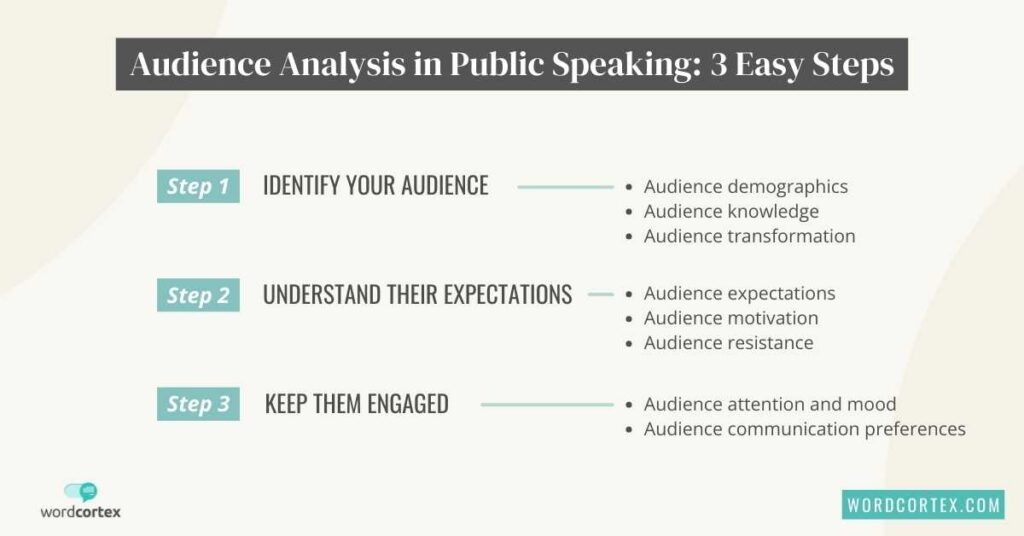
Step 1: Identify Your Audience
Before you start working on your presentation, one of the most important questions to ask yourself is: Who am I speaking to?
We’ll start by examining the audience demographics (profession, background, age, and so on). Next, we’ll consider audience knowledge — what do they likely already know about this topic? Finally, we’ll determine the audience transformation — how should they think, feel, or act differently by the end of your presentation?
Knowing who they are, what they need from you, and how you can impact them, makes your presentation more relevant, engaging, and persuasive.
Audience demographics:
- Who will be in the audience? What are they like?
Start by identifying the professional titles or roles of the people in the audience — for example, academics, students, marketers, entrepreneurs, and so on.
Now, based on your presentation topic and the goals of your presentation, you can either keep it general (i.e., students) or get more specific (i.e., medical students in their first year, or undergraduate students studying business).
In connection with your presentation topic, ask: ‘What does a typical day in their life look like?’. If we were to continue with our ‘student audience’ example, you’d have: need to attend classes, deliver assignments on time, study for tests, and so on.
Why this is important:
For instance, if a career coach is speaking to a student audience, the speaker will need to know the specifics of the audience — whether the students are undergraduates or postgraduates, what degree they’re pursuing, and their career prospects. Getting specific with audience demographics, in this case, will ultimately determine the success of this presentation.
On the other hand, if a software company executive is demonstrating how to access online classes to students, it’s OK to stay general with the audience demographics.
Examples of audience analysis in public speaking: Identifying audience demographics
→ Example 1: Career development training
GENERAL
Students
SPECIFIC
• Undergraduate students studying business
• Final-year medical students
• Moms returning to work
→ Example 2: Project management software demo
GENERAL
Corporate professionals
SPECIFIC
• Marketers working in a fast-paced agency
• Editorial team at a publication
• Freelancers handling multiple projects
→ Example 3: Scientific research presentation
GENERAL
Academics
SPECIFIC
• Scientists studying molecular biology
• Committee members of a funding body
• Public health conference attendees
Many articles about audience analysis in public speaking will mention the need to segment the audience further into age, gender, ethnicity, and race. If these factors will influence the outcome of your presentation, by all means, go for it. For example, if a career coach is speaking at a ‘women in science’ conference, gender becomes an important consideration for the presentation.
However, if audience age, gender, ethnicity, and race don’t impact your presentation, you can just focus on the professional roles of the folks in your audience.
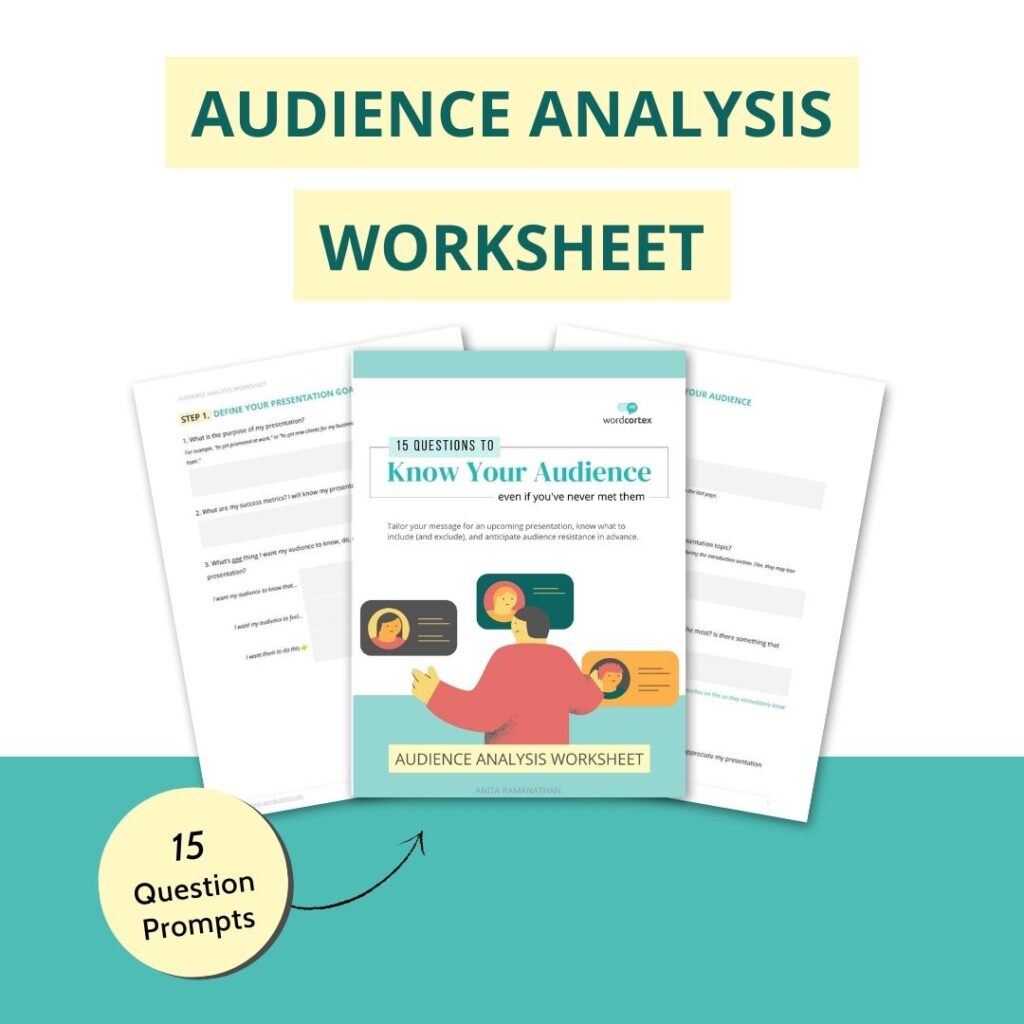
Get Your FREE ‘Audience Analysis’ Worksheet
Follow along with my free audience analysis worksheet that contains fill-in-the-blank question prompts and multiple-choice options to help you plan.
Audience knowledge:
- What do they already know about my presentation topic?
- What do they need to know?
One of the quickest ways to lose an audience is by not meeting them at their knowledge level. Make things too basic, and you stand the risk of losing their interest. Equally, get overly technical too fast, and you lose them because it’s all too overwhelming.
The sweet spot, I’ve noticed, is to start at or slightly below the assumed knowledge level of the audience, and then proceed to move upwards bit by bit to impart new knowledge or challenge existing ideas.
An easy way to determine the knowledge level of an audience is through their profession or job titles.
Let’s take an example: If the speaker is demonstrating a new project management software to marketers, it’s likely that the people in the audience already know how projects need to be managed. (So, starting with the basics of project management will cause them to lose interest fast.) What they need to know, instead, is how to use this software to manage projects effectively. That’s the knowledge level at which the speaker should ideally start the presentation.
Why this is important:
Making your message too simple can cause well-informed audiences to quickly lose interest and get bored. Meanwhile, getting into the nitty-gritty technicalities too quickly can alienate those who need a bit more background on the topic.
Below are a few more specific examples of assessing audience knowledge levels.
Examples of audience analysis in public speaking: Assessing audience knowledge
→ Example 1: Career development training
What do they already know?
• Networking is important in career development
What do they need to know?
• How to expand your network using LinkedIn
→ Example 2: Project management software demo
What do they already know?
• Project management tasks are tedious and time-consuming
What do they need to know?
• It’s possible to set custom templates and automate some tasks to save time
→ Example 3: Scientific research presentation
What do they already know?
• They are experts in protein biology
What do they need to know?
• There’s a new method to isolate proteins
Audience transformation:
- How will I transform my audience: how should they think, feel, or act differently by the end of my presentation?
Now that you have a general idea of who is in your audience and what they likely know about your topics, map out the ‘before’ and ‘after’ journey of your audience, with your presentation serving as the path.
Fill out this prompt: At the end of my presentation, I want my audience to ___________________.
Don’t overthink it! Even a small change in the audience’s viewpoint goes a long way.
Step 2: Understand Their Expectations
Next step: let’s determine what your audience expects from your speech. This means, taking a closer look at the audience’s psychographics.
Audience psychographics can be broadly defined by how audience members feel about your topic — what they believe, what ideas they currently support or oppose, and their attitudes toward the topic.
Although that may seem like a daunting task — How am I supposed to know what their beliefs are?
Not to worry. I’ve broken down this process into simple questions that you can ask about your audience, along with real-life examples.
Audience expectations:
- Why are they here?
- What do I want them to know or do at the end of my presentation?
Take a closer look at what your audience hopes to gain from your presentation. Are they here to learn something new from your talk? Or are they here because you’re offering a solution to their problem?
In some instances, attendance can be mandatory (we’ll cover this below), in which case, the onus is on you to get them excited about your talk.
At this stage in the audience analysis, it’s equally important to set your expectations from this presentation: what do you want your audience to do or know?
Write down: “At the end of my presentation, I want my audience to _________.”
Why this is important:
Knowing what your audience will get out of your presentation will determine how you structure your talk. Remember, each audience member is quietly thinking, ‘What’s in it for me?’.
You can also modify your presentation title to match your audience’s expectations.
Examples of audience analysis in public speaking: Understanding audience expectations
→ Example 1: Career development training
Audience expectations
• How is this better than what I already use?
• Will this software save me time?
→ Example 2: Project management software demo
Audience expectations
• How is this better than what I already use?
• Will this software save me time?
→ Example 3: Scientific research presentation
Audience expectations
• Are there any new or interesting experimental methods being used?
• Why are these findings important?
Audience motivation:
- Why are they here?
- What do I want them to know or do at the end of my presentation?
If attending the presentation is mandatory, you can imagine that people have dragged themselves to be in the audience because they have to. In this case, it’s all the more important to start the presentation off directly addressing the audience’s needs or challenges.
In fact, I’d go one step further and even modify the presentation title to make it more catchy or intriguing so you’ve got people excited even before the talk starts.
When you have willing participants, say, at a conference or an open presentation at a company, they’ve already given you a vote of confidence that they’re interested in the topic.
To keep your audience motivated to listen to your presentation, consider identifying any challenges or frustrations they may experience related to your presentation topic. Mention these within the first few minutes of the speech to get your audience leaning in and paying attention.
In some cases, audience challenges or frustrations may not be applicable as the presentation is purely informative.
Examples of audience analysis in public speaking: Identifying audience challenges or frustrations
→ Example 1: Career development training
Audience challenges
• “I’ve applied to so many job listings but not getting any interview calls.”
• “I use LinkedIn but I’ve not had success with networking.”
→ Example 2: Project management software demo
Audience challenges
• “We spend too much time going back and forth on emails about project status.”
• “Repetitive tasks are tedious.”
→ Example 3: Scientific research presentation
Audience challenges
Not necessarily applicable. The audience is looking to gain new knowledge about a topic of interest.
Audience resistance:
- How might they resist my message? (Consider preconceived opinions, biases, or genuine concerns about the presentation topic.)
- How will I overcome this resistance?
The final step in understanding audience expectations is to anticipate why they might resist your message.
Resistance can come during your presentation in the form of disengagement or negative body language, or towards the end, where your ‘call to action’ isn’t being acted upon or the questions being asked signal that the message hasn’t resonated with them.
While it’s hard to know all the ways in which your message might meet resistance, below are some likely reasons.
Examples of audience analysis in public speaking: Anticipate audience resistance
Here are some common reasons why people in the audience may resist your message:
Too complex
Audience confused by overtly technical and jargon-heavy content
Too basic
The audience knowledge level is much higher than the content presented
Information overload
Too much information packed into a presentation with no clear takeaways
Misinformation
The audience may have preconceived notions or biases that aren’t addressed
Fear of change
The new ideas or practices being presented challenge current beliefs or habits
Lack of trust
The audience requires additional credible sources and proven results
Pressed for time
Busy executives need quick takeaways instead of long explanations
Too expensive
They already know the solution you’re presenting is above their budget
Too difficult
The idea or solution being presented seems far too tedious and challenging
Remember, by anticipating audience expectations, their motivators, and potential pushback, you’re one step closer to crafting a speech that meets them where they are and keeps them engaged.
Which brings us to…
Step 3: Keep Them Engaged
Alright, let the fun times roll! This is, by far, the most enjoyable part of audience analysis (at least in my opinion.)
In step #3, our goal is to generate ideas to keep our audience engaged — and equally, pinpoint any reasons why they might get distracted or fatigued.
Contextual factors such as audience mood, room setup, and potential distractions can influence how the audience receives your message.
A few simple fixes (such as a pace change or a short audience activity), can win back your audience’s attention, keeping them involved and eager to hear what’s next.
Audience attention and mood:
- Why might they get distracted?
- Why might they get fatigued?
Several factors can influence how distracted or fatigued your audience can become during the length of your presentation.
We’ve covered intrinsic motivators in the section above. Here, we’ll look at extrinsic factors, also known as situational analysis.
Below are some situational or extrinsic factors that can affect audience attention spans.
Adjust your delivery style, vocal projection, and pacing to boost audience energy levels. Plan 1-2 interactive activities as part of your presentation to help your audience stay engaged. (This can be as simple as a ‘raise your hand’ activity.)
Example of audience analysis in public speaking: Factors that affect audience attention and mood
Physical setting
- Physical vs. virtual presentation
- Audience size
- Clarity of audio-visuals
- Interruptions
- Audience comfort level
Time of day and schedule
- First vs. last talk of the day
- Speaking just before lunchtime
- Speaking after lunch
- Speaking while beverages are being served
- Longer presentations (over 30 minutes)
Audience communication preferences:
- Does this audience have additional preferences for receiving information?
Even though this is a presentation, it’s sometimes helpful to note if your audience has strong preferences for how they wish to receive additional information from you.
People absorb and retain information differently. So, offering other communication channels can make your presentation more effective.
For example, managers often ask for a one-page executive summary after the presentation. Students benefit from lecture handouts. Potential customers would like a QR code or a URL to leisurely view the product.
To assess additional communication preferences for your audience, ask: “How can make it easier for this audience to remember my message?”
Below are a few ways to supplement your presentation based on audience communication preferences:
- Printed handouts
- One-page summaries
- Follow-up email
- Follow-up call
- QR code or URLs
- Presentation recordings
- Copy of slide deck
- PDF downloads
- Shared folder containing resources
- One-on-one conversation
- Customer support number

Audience Analysis Methods: How to Get Audience Information? And How Much Time to Spend?
Conducting an audience analysis for public speaking can be as simple as using your best judgment about the audience or it can be as involved as sending out a survey to learn more about your audience. It depends on how consequential the presentation is.
That can also determine how much time to spend on audience analysis.
In the popular presentation book Slide:ology, author Nancy Duarte recommends spending 6-20 hours on research and collecting information from various sources, and then spending 1 hour identifying the audience’s needs.
That might seem like a lot for everyday work presentations. On the other hand, for once-in-a-lifetime, career-defining presentations, it might be well worth your time doing an in-depth audience analysis.
The bottom line is:
While not every presentation will require a detailed audience analysis, high-stakes presentations warrant a robust deep dive into their audience to achieve the desired outcomes.
To simplify the audience analysis process, I’ve included a few different options based on how much time you have (or how consequential your presentation will be).
When you have limited time or it’s a low-risk presentation:
- Use your best judgment
- A quick email or call to the event organizer
- Review past presentations on the organizer’s website
- Ask ChatGPT (you’d be surprised by the level of detail it can provide)
- Arriving early to meet the organizer and a few attendees (a bit risky, if you ask me!)
When you have a bit more time or it’s a high-stakes presentation:
- Send a survey to the event organizer
- Conduct interviews with a few potential attendees
- Ask previous speakers about their experience
- Look at past social media entries or hashtags to understand audience expectations
- Seek feedback from trusted colleagues or a similar audience
- If applicable, review available market research data on the audience demographics or conduct one of your own (for sales presentations or product launches)
Concluding Thoughts on Audience Analysis
Knowing your audience and understanding them on a deeper level before your presentation is an essential part of public speaking success. It’s the only way to craft a message that truly resonates with your audience.
Whether you spend hours on this step or a few minutes, I’d urge you to take that extra time to analyze your audience.
My free ‘Audience Analysis worksheet’ can be a helpful resource to jumpstart your audience analysis process (and even make it fun). It contains question prompts and multi-choice options to help you know your audience. Plus, it can be re-used for different types of presentations.

Get Your FREE ‘Audience Analysis’ Worksheet
Follow along with my free audience analysis worksheet that contains fill-in-the-blank question prompts and multiple-choice options to help you plan.
Frequently Asked Questions (FAQs)
What if my audience has mixed levels of knowledge on my topic?
Start with a simple explanation to bring everyone up to speed, then dive deeper for those with more expertise. Use relatable analogies to bridge knowledge gaps, and engage in regular check-ins to make sure they’re following along.
What if I’m speaking to a mixed audience?
If you’re addressing a mixed audience, which is a rather common occurrence, decide which audience subset is a priority for your presentation’s success. Tailor your message to this ‘priority’ group. Read more about speaking to mixed audiences here.
What if I have a highly skeptical or resistant audience?
First, remind yourself that it’s OK for others to respectfully disagree with you.
Try to build trust by citing credible sources or showing proven results. Use social proof from individuals who are similar to your audience. Engage in logical arguments rather than emotional ones. Encourage audience questions and address skepticism with facts.
Can I adjust my speech on the spot if I misread my audience?
Absolutely! Pay attention to audience reactions in real time. If you’re being met with confused faces or negative body language (crossed arms, hands covering face), it’s time to pivot.
Pause, and calmly ask: “Does that make sense?” or “What questions do you have for me at this stage?” Elaborate on or simplify key points according to audience feedback. Incorporate mini Q&A sessions at different points during the presentation to keep them engaged, addressing any concerns along the way.
Get actionable communication tips straight to your inbox
No fluff. Just valuable insights and practical strategies to communicate better.
We promise to keep your email address safe.
By signing up, you agree to receiving communication tips and sporadic updates from Word Cortex. You can unsubscribe anytime.
